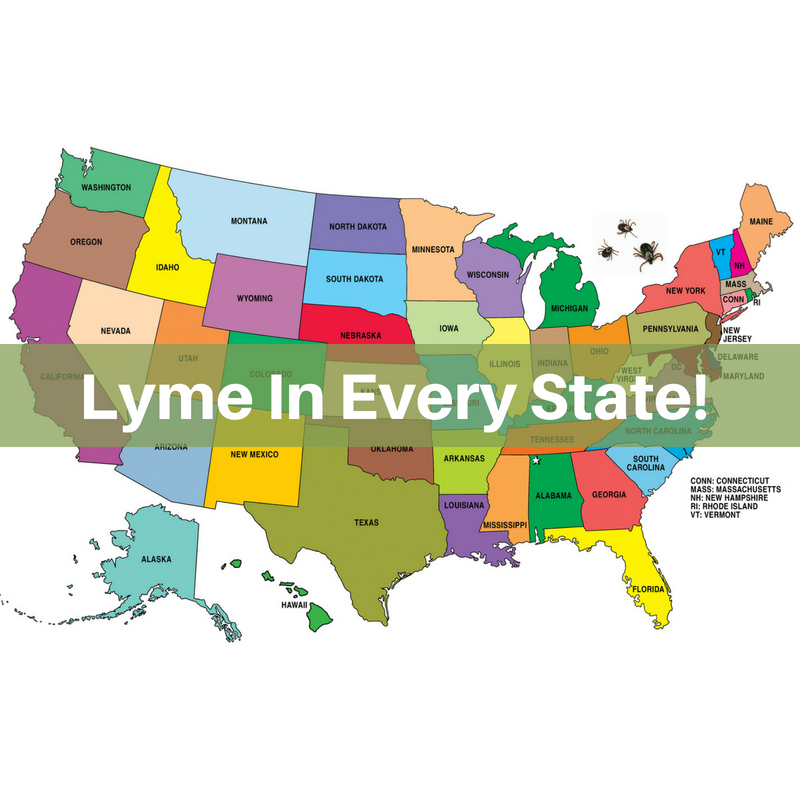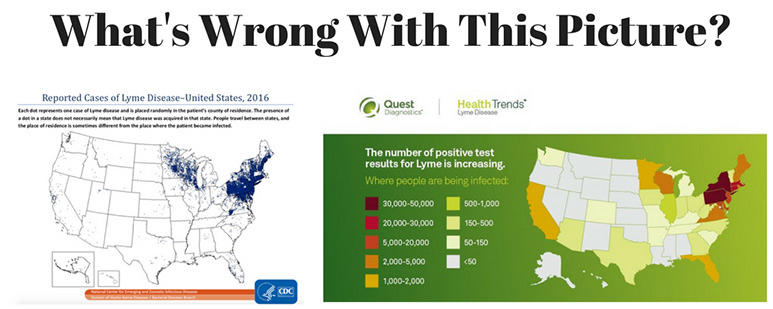LYME SCI: Lyme has been found in all 50 states and is on the rise

Quest Diagnostics has released its findings from over six million Lyme disease lab tests taken over the last seven years.
Quest’s report says Lyme has been detected in all 50 states and the District of Columbia—and that the number of cases continues to rise nationwide.
This report provides the first national analysis of Lyme disease based on laboratory data. (See here for similar data based on insurance claims.)
Quest Reports Lyme Disease Spike
According to Quest’s report, 60% of Lyme disease cases occur in the Northeastern United States, with a decided spike in the last few years.
Pennsylvania registered the most positive test results in the nation, with 10,001 cases in 2017, followed by six New England states (Connecticut, Maine, Massachusetts, New Hampshire, Rhode Island and Vermont) reporting another 11,549 cases combined.
More surprising to me was the exponential increase in the number of positive test results found in California and Florida, two states often dismissed by the CDC as not having very much Lyme disease.
What’s most disturbing about these numbers is the huge discrepancy between the positive test results and the number of cases reported by the CDC.
Comparing Quest and CDC Lyme Disease Map
First, let’s look at the big picture by comparing the CDC map (each dot represents one CDC positive case), and the Quest map showing the number of positive test results. Note, the Northeast looks pretty similar between the two maps, but what is going on in the South and West? Why such glaring discrepancy?
Comparing Quest’s numbers to the latest CDC Lyme Disease data.
In 2015, Quest found 164 cases of Lyme disease in California—while the CDC acknowledged only 83 cases. (California has mandatory lab reporting of Lyme disease. So, those cases from Quest were reported to state officials—and then what happened?)
That same year, Quest found 283 cases in Florida while the CDC reported 116.
In 2016, Quest again shows twice the CDC totals for California, but an even bigger gap emerges in Florida, with Quest reporting three times as many as the CDC. See below:
And look at 2017! According to Quest, California’s positive Lyme tests increased 195% over the two-year period from 2015 to 2017. Florida showed a 77% increase over the same time span. (CDC figures for 2017 are not yet available.)
And, keep in mind, Quest is only one of many laboratories in the U.S. What about positive Lyme tests from other labs?
Ticks are spreading
LymeDisease.org’s own research project, MyLymeData, has also detected discrepancies between the CDC-reported cases and the number of patients with positive tests for Lyme in the South and West. [See LYMEPOLICYWONK: Why Doesn’t the CDC Count Lyme Disease Cases in the South and the West? Everybody Else Does.]
The spread of Lyme disease makes sense with the latest NIH report showing the Ixodes scapularis tick, the primary source of Lyme disease, being found in nearly 50 percent more U.S. counties in 2015 than was detected in 1996.
Further confirming the increasing spread, a recent citizen science study also found Ixodes scapularis ticks in 83 counties (in 24 states) where these ticks had not been previously recorded. But why?
Dr. Harvey Kauffman, of Quest Diagnostics, says, “Our data show that positive results for Lyme are both increasing in number and occurring in geographic areas not historically associated with the disease. We hypothesize that these significant rates of increase may reinforce other research suggesting changing climate conditions that allow ticks to live longer and in more regions may factor into disease risk.”
It’s past time to take ticks seriously
Lyme disease is only one of 16 tick-borne disease found within the United States. How many other illnesses are being undiagnosed and/or underreported? Is there also a 10-fold difference in reporting of anaplasmosis, babesiosis, rickettsiosis and other tick-borne pathogens, including viruses?
The CDC recently acknowledged that 75% of all reported vector-borne illnesses come from ticks, and of those, most are cases of Lyme disease
Underreporting of Lyme and other tick-borne diseases is a huge problem. It’s time to fix it.
LymeSci is written by Lonnie Marcum, a Licensed Physical Therapist and mother of a daughter with Lyme. Follow her on Twitter: >@LonnieRhea Email her at: lmarcum@lymedisease.org .
Reference:






















We invite you to comment on our Facebook page.
Visit LymeDisease.org Facebook Page